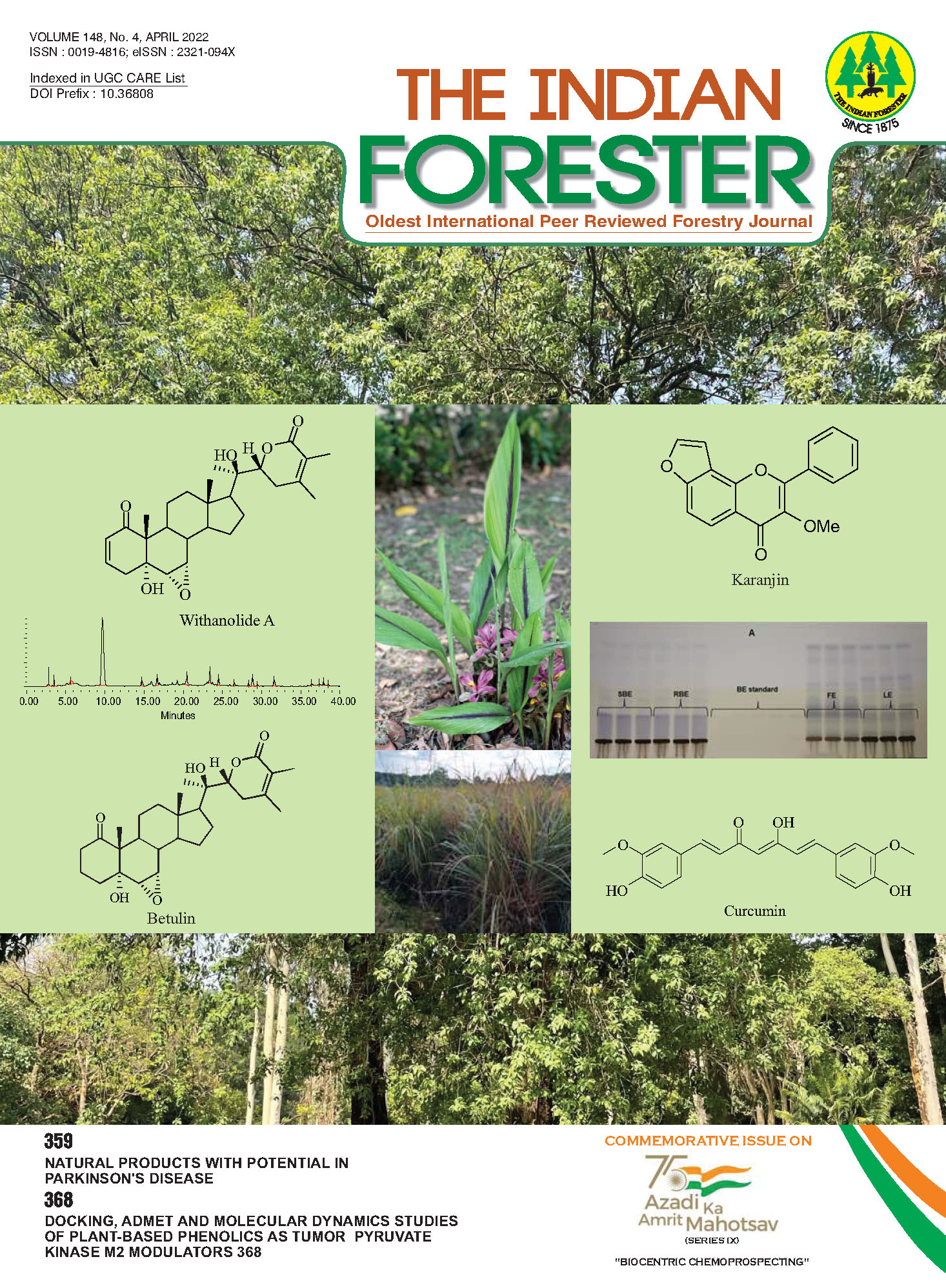Variability for Oil, α- and β-santalol Content in Indian Sandalwood (Santalum album L.) from Marayoor Sandalwood Reserve – The Only Natural Population in India
DOI:
https://doi.org/10.36808/if/2022/v148i4/168347Keywords:
α, - and β, -Santalol, Girth at Breast Height, Indian Sandalwood, Oil, Marayoor.Abstract
Indian Sandalwood (Santalum album L.) is categorized as 'vulnerable' by International Union for Conservation of Nature. Marayoor Sandalwood reserve in the Kerala state is the only natural sandalwood reserve in India and perhaps in the world having substantial Santalum album (Indian Sandalwood) trees. Variation for oil and its major constituents i.e., α- and β- santalol of the Sandalwood trees in this reserve has been attempted for the first time. Core samples were collected from trees of different girth size ranging from 30 to 140 cm. The sandalwood oil was extracted from the core samples using solvent extraction method. Oil content ranged from 1.3% to 6.2%. From the extracted oil, α- and β- santalol content was estimated by using Gas chromatography/Mass spectrometry. The α- and β- santalol content varied from 45.17 to 55% and 18.3 to 27% (w/w) respectively. There was no relationship between tree girth, oil, and santalols content. Considerable variation exists in the natural population for oil content and sufficient care has to be taken while selecting superior genotypes.References
Arunkumar A.N., Dhyani A. and Joshi G. (2019). Santalum album. The IUCN red list of threatened species.
Arunkumar A.N., Joshi G., Rao M.S., Rathore T.S. and Ramakantha V. (2016). The population decline of Indian sandalwood and people's role in conservation-an analysis. Climate change challenge (3C) and social-economicecological interface-building, environmental science, (Eds: S. Nautiyal et. al.), Springer International Publishing, Switzerland.
Balasundaran M. (2010). Improving sandal population in Marayur sandal reserves through assisted natural regeneration. KFRI research report No. 349, Kerala Forest Research Institute, Thrissur, India.
Bisht S.S., Chandra G. and Pandey K.K. (2021). Simple and rapid FTIR spectral data and chemometric analysis-based method for evaluation of the quality of Indian sandalwood oil. Journal of Essential Oil Research, 33(4): 376-384.
Bisht S.S., Chandra G., Ravindra M. and Kumar R. (2020). Evaluation of chemical and physical properties of commercial sandalwood essential oils and their comparison with essential oil extracted from Santalum album L. Journal of Essential OilBearing Plants, 23(2): 345-355.
Bisht S.S., Ravindra M. and Gayathri D.N. (2019). Variability in yield and composition of oil from Indian sandalwood (Santalum album L.) trees grown in homogeneous conditions. Tropical Plant Research, 6(1): 31-36.
Brand J.E., Norris L.J. and Dumbrell I.C. (2012). Estimated heartwood weights and oil concentrations within 16-year-old Indian sandalwood (Santalum album) trees planted near Kununurra, Western Australia. Australian Forestry, 75(4): 225-232.
Hasegawa T., Izumi H., Tajima Y. and Yamada H. (2012). Structure-odor relationships of α santalol derivatives with modified side chains. Molecules, 17(2): 2259-2270.
Hettiarachchi D.S., Gamage M. and Subasinghe U. (2010). Oil content analysis of sandalwood: A novel approach for core sample analysis. Sandalwood Research Newsletter, 25: 1-4.
Jones C.G., Ghisalberti E.L., Plummer J.A. and Barbour E.L. (2006). Quantitative co-occurrence of sesquiterpenes; a tool for elucidating their biosynthesis in Indian sandalwood, Santalum album. Phytochemistry, 67(22): 2463-2468.
Kumar A.A.N., Joshi G. and Ram H.M. (2012). Sandalwood: history, uses, present status and the future. Current Science, 103(12): 1408-1416.
Misra B.B., Das S.S. and Dey S. (2013). Volatile profiling from heartwood of East Indian sandalwood tree. Journal of Pharmacy Research, 7(4): 299-303.
Page T., Southwell I., Russell M., Tate H., Tungon J., Sam C., Dickinson G., Robson K. and Leakey R.R. (2010). Geographic and phenotypic variation in heartwood and essential-oil characters in natural populations of S a n t a l u m austrocaledonicum in Vanuatu. Chemical Biodiversity, 7(8): 1990-2006.
Shankaranarayana K.H., Ravikumar G., Rajeevalochan A.N., Theagarajan K.S. and Rangaswamy C.R. (1998). Content and composition of oil from the central and transition zones of the sandalwood disc. In: Sandal and its products, Australian Centre for International Agricultural Research Proceedings, 84: 86-88.
Srinivasan V.V., Sivaramakrishnan V.R., Rangaswamy C.R., Ananthapadmanabha H.S. and Shankaranarayana K.H. (1992). Sandal (Santalum album L.), ICFRE, Dehra Dun.
Subasinghe S.M.C.U.P, Samarasekara S.C., Millaniyage K.P. and Hettiarachchi D.S. (2017). Heartwood assessment of natural Santalum album populations for agroforestry development in Sri Lanka. Agroforestry System, 91: 1157-1164.
Subasinghe U., Gamage M. and Hettiarachchi D.S. (2013). Essential oil content and composition of Indian sandalwood (Santalum album) in Sri Lanka. Journal of Forestry Research, 24(1): 127-130.
Viswanath S., Bhaskar D. and Rathore T.S. (2009). Domestication of Sandal (Santalum album L.) in India: constraints and prospects. APA News, 34(9): 9-12.
Downloads
Downloads
Published
How to Cite
Issue
Section
License
Unless otherwise stated, copyright or similar rights in all materials presented on the site, including graphical images, are owned by Indian Forester.





